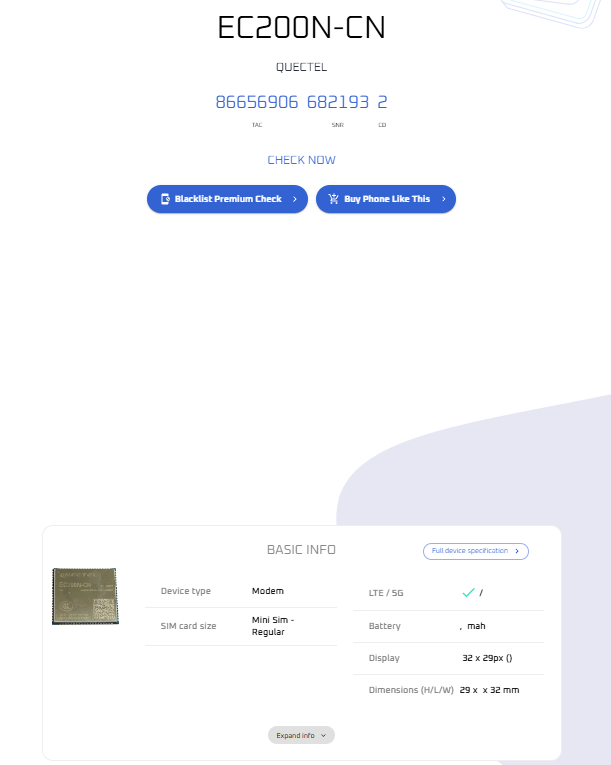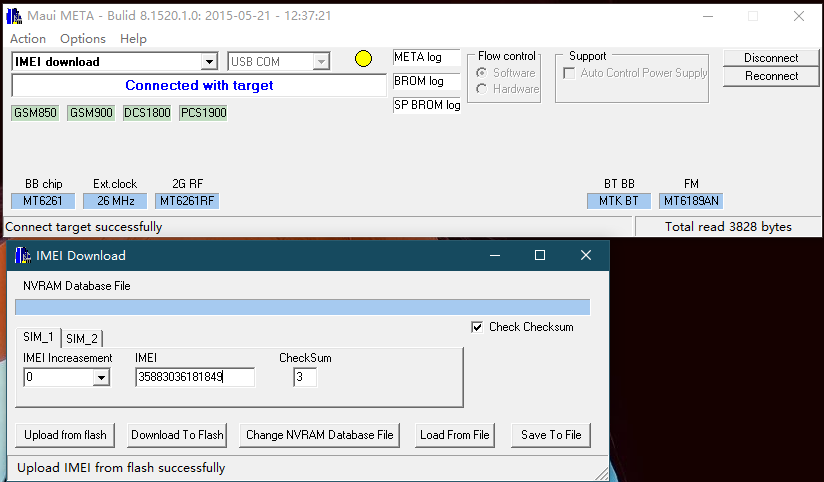一、IMEI的定义
IMEI(International Mobile Equipment Identity,国际移动设备识别码)是用于唯一识别一部物理移动设备(如手机、平板、蜂窝模块等)的15位数字编码。其规则由全球移动通信系统协会(GSMA)制定,遵循严格的结构和校验机制。
二、IMEI 的基本结构
1、标准15位 IMEI(最常见)格式: AA-BBBBBB-CCCCCC-D
(1)TAC(Type Allocation Code,型号核准码):前 8位 (AA-BBBBBB)
前2位是厂商代码,后6位是设备型号代码。
前两位代码:代表分配机构的标识符(Reporting Body Identifier),由GSMA指定:比如
01:美国CTIA
35:英国BABT(主要机构)
86:中国TAF(电信终端产业协会)
后六位代码:由分配机构根据设备型号自定义分配,确保全球唯一性。
参考 FAC 码:IMEI 码的第 7、8 位是 FAC 码,即最后装配号,一般代表产地。例如,Nokia 手机中,10 为芬兰,20 为德国,30 为韩国,40 为中国北京,60 为中国东莞;SonyEricsson 手机中,10 为法国,51 为瑞典,71 为马来西亚等。不过,现在部分厂商的 FAC 码可能不再具有明确的产地指示意义。

(2)SNR(Serial Number,序列号):第9~14位 (CCCCCC)
由厂商分配,唯一标识同型号设备。
(3)CD(Check Digit,校验位):第15位
通过Luhn算法计算得出,用于验证IMEI有效性
Luhn 算法的特性:可检测单个数字错误(如输入错误)和相邻数字交换错误。
2、Luhn算法计算步骤(除 IMEI 外,信用卡号、部分身份证号也采用此算法)
(1)、取前14位数字,左边第一位开始算第一位(奇数位),奇数位不变。偶数位乘以2,若乘以2后≥10,则将数字相加(如 8*2=16 → 1+6=7)。得到新序列。
(2)、将所有新序列数字求和。
(3)、总和乘以 9,结果的个位数即为校验位。
3、Luhn算法举例
(1)原始的序列前14位是: 86656906682193
经过第一步后得到的序列是:83616903672296
(2)所有新序列的数字相加: 8+3+6+1+6+9+0+3+6+7+2+2+9+6=68
(3)68*9=612,那么校验位就是2
最终的15位IMEI是:866569066821932
三、IMEI的作用
可以参考GSMA官网的论述。
https://www.gsma.com/get-involved/working-groups/terminal-steering-group/imei-database/
The GSMA provides a collection of services previously known as the IMEI DataBase (IMEI DB). The services enable the mobile ecosystem to assign, understands, reports and checks the status of IMEIs that are in use across the world’s mobile networks.
Each IMEI consists of 3 key parts – Type Allocation Code (TAC), Serial Number and a Check Digit. The GSMA allocates official TAC numbers to manufacturers of 3GPP compliant devices under the TAC Allocation service. The device manufacturers submit allocation requests with information such as the manufacturer name, device models, and selected technical capabilities (e.g. frequency bands supported). Once validated by GSMA, TAC is allocated to the device manufacturers for production.
It is possible for organisations to access the TAC Allocation data via the GSMA Device Database. Ecosystem participants such as network operators use the information to determine types of devices on their networks, and what features the devices supports. This information is crucial for understanding network usage and management strategy such as sunsetting older generation networks and investing on new services such as eSIM support. Other organisations may also use the information for their operations such as device management, customer support and device trade-in .
Mobile Devices remain an attractive target for criminals around the world. Part of the service suite includes Device Registry. Using mobile devices’ IMEI numbers, the Device Registry database allows participants – including mobile operators, device manufacturers, device insurers and inventory managers – to report IMEIs of devices that have been reported stolen to help prevent their connection to mobile networks.
The Device Registry also supports what is known as a “block list”. The block list is a list of IMEIs that are associated with mobile devices that should be denied service on mobile networks because they have been reported as lost, stolen, faulty or otherwise unsuitable for use. This list is stored in the Device Registry and acts as a central system (also known as Central Equipment Identity Register) for network operators to share their individual block lists so that devices denied service (blocklisted) by one network will not work on other networks. The collaboration between of governments and law enforcement agencies and the network operator community continues in a number of markets where handset theft is perceived to be a problem. GSMA strongly encourages the use of the GSMA Device Registry as a platform to exchange stolen handset data. All GSMA operator members are welcome to connect to the system free of charge.
The GSMA also runs GSMA Device Check which allows recyclers, insurers, law enforcement, and other stakeholders to check if a device has been reported stolen before purchase.
达盟GPS小编把上面的网页直接丢给豆包,翻译如下:
IMEI 数据库
国际移动设备识别码(IMEI)是移动网络中设备的 15 位唯一标识符。
全球移动通信系统协会(GSMA)提供一系列服务,此前这些服务被统称为 IMEI 数据库(IMEI DB)。通过这些服务,移动生态系统能够分配、了解、上报并核查全球移动网络中正在使用的 IMEI 状态。
每个 IMEI 均包含三个关键部分 —— 型号批准码(TAC)、序列号(Serial Number)和校验位(Check Digit)。GSMA 通过 TAC 分配服务,向生产符合第三代合作伙伴计划(3GPP)标准设备的制造商分配官方 TAC 码。设备制造商需提交分配申请,并提供制造商名称、设备型号以及选定的技术参数(如支持的频段)等信息。经 GSMA 验证通过后,TAC 码将分配给设备制造商,供其用于生产。
各类组织可通过 GSMA 设备数据库访问 TAC 分配数据。移动生态系统参与者(如网络运营商)可利用这些信息确定其网络中的设备类型以及设备支持的功能。该信息对了解网络使用情况和制定管理策略至关重要,例如淘汰旧代网络、投资 eSIM 支持等新服务。其他组织也可将这些信息用于自身业务,如设备管理、客户支持和设备以旧换新。
移动设备仍是全球犯罪分子的主要目标之一。上述服务套件的一部分包括设备注册库(Device Registry)。借助移动设备的 IMEI 号,设备注册库允许参与者(包括移动运营商、设备制造商、设备保险公司和库存管理者)上报已被报失的被盗设备的 IMEI 号,助力防止这些设备接入移动网络。
设备注册库还支持所谓的 “黑名单(block list)” 功能。黑名单是一份与移动设备相关联的 IMEI 列表,这些设备因被报失、被盗、存在故障或其他不适合使用的情况,应被拒绝接入移动网络。该列表存储在设备注册库中,并充当一个中央系统(也称为中央设备身份寄存器,CEIR),供网络运营商共享各自的黑名单,确保被某一网络拒绝服务(列入黑名单)的设备无法在其他网络上使用。在许多认为手机盗窃问题突出的市场中,各国政府、执法机构与网络运营商群体持续开展合作。GSMA 强烈鼓励将 GSMA 设备注册库用作交换被盗手机数据的平台,所有 GSMA 运营商成员均可免费接入该系统。
此外,GSMA 还运营着 “GSMA 设备核查(GSMA Device Check)” 服务,该服务允许回收商、保险公司、执法机构及其他相关方在购买前核查某一设备是否已被报失为被盗设备。
这段的核心观点:GSMA分配IMEI号,若IMEI失效需要向GSMA申报,失效/被盗的IMEI可以加入黑名单,应该被拒绝接入移动网络。
四、如何通过IMEI查询产品信息
在GSMA官网上查询IMEI,需要注册,有点麻烦。有个不用注册的,
我测试了一下,也是比较准的。比如:

五、IMEI是否可以随意修改
因为我们做的是GPS北斗定位器(Tracker),因为不怎么涉及到打电话,就是使用流量上网而且多是小流量的,所以运营商管控的就没那么严格。若不是出国使用,很多厂家都自己定义IMEI号码了。比如用MTK的Meta工具都可以读写IMEI,IMEI可以自己定义。

出国使用GPS定位器就必须严格按gsma规定的方式,不能随意修改IMEI。报关都需要用到。手机是必须严格定义IMEI的,不能修改。
